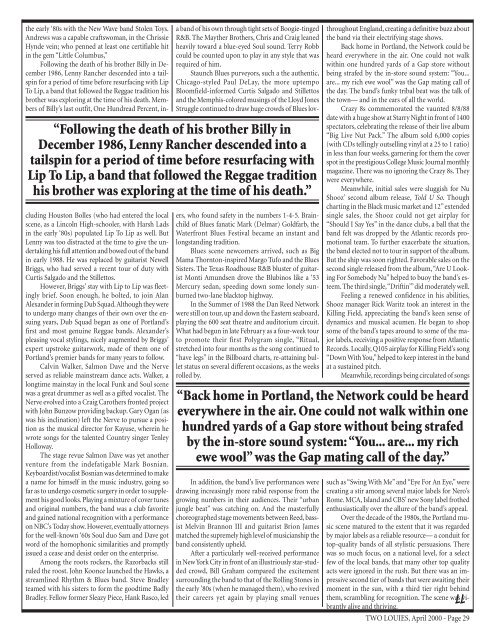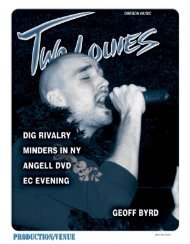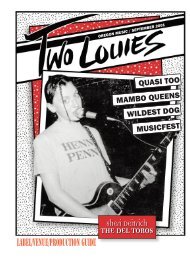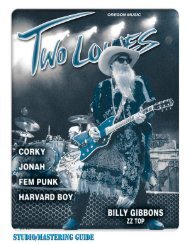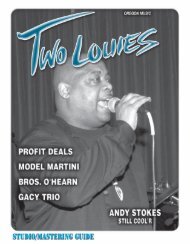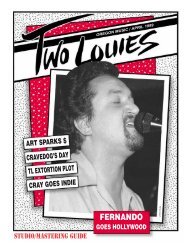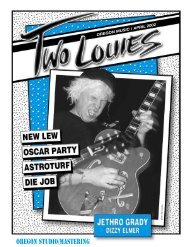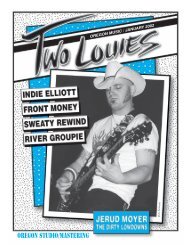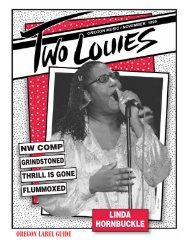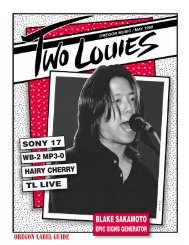2L April 00 Studio - Two Louies Magazine
2L April 00 Studio - Two Louies Magazine
2L April 00 Studio - Two Louies Magazine
Create successful ePaper yourself
Turn your PDF publications into a flip-book with our unique Google optimized e-Paper software.
the early ‘80s with the New Wave band Stolen Toys.<br />
Andrews was a capable craftswoman, in the Chrissie<br />
Hynde vein; who penned at least one certifiable hit<br />
in the gem “Little Columbus,”<br />
Following the death of his brother Billy in December<br />
1986, Lenny Rancher descended into a tailspin<br />
for a period of time before resurfacing with Lip<br />
To Lip, a band that followed the Reggae tradition his<br />
brother was exploring at the time of his death. Members<br />
of Billy’s last outfit, One Hundread Percent, in-<br />
cluding Houston Bolles (who had entered the local<br />
scene, as a Lincoln High-schooler, with Harsh Lads<br />
in the early ‘80s) populated Lip To Lip as well. But<br />
Lenny was too distracted at the time to give the undertaking<br />
his full attention and bowed out of the band<br />
in early 1988. He was replaced by guitarist Newell<br />
Briggs, who had served a recent tour of duty with<br />
Curtis Salgado and the Stillettos.<br />
However, Briggs’ stay with Lip to Lip was fleetingly<br />
brief. Soon enough, he bolted, to join Alan<br />
Alexander in forming Dub Squad. Although they were<br />
to undergo many changes of their own over the ensuing<br />
years, Dub Squad began as one of Portland’s<br />
first and most genuine Reggae bands. Alexander’s<br />
pleasing vocal stylings, nicely augmented by Briggs’<br />
expert upstroke guitarwork, made of them one of<br />
Portland’s premier bands for many years to follow.<br />
Calvin Walker, Salmon Dave and the Nerve<br />
served as reliable mainstream dance acts. Walker, a<br />
longtime mainstay in the local Funk and Soul scene<br />
was a great drummer as well as a gifted vocalist. The<br />
Nerve evolved into a Craig Carothers fronted project<br />
with John Bunzow providing backup. Gary Ogan (as<br />
was his inclination) left the Nerve to pursue a position<br />
as the musical director for Kayuse, wherein he<br />
wrote songs for the talented Country singer Tenley<br />
Holloway.<br />
The stage revue Salmon Dave was yet another<br />
venture from the indefatigable Mark Bosnian.<br />
Keyboardist/vocalist Bosnian was determined to make<br />
a name for himself in the music industry, going so<br />
far as to undergo cosmetic surgery in order to supplement<br />
his good looks. Playing a mixture of cover tunes<br />
and original numbers, the band was a club favorite<br />
and gained national recognition with a performance<br />
on NBC’s Today show. However, eventually attorneys<br />
for the well-known ‘60s Soul duo Sam and Dave got<br />
word of the homophonic similarities and promptly<br />
issued a cease and desist order on the enterprise.<br />
Among the roots rockers, the Razorbacks still<br />
ruled the roost. John Koonce launched the Hawks, a<br />
streamlined Rhythm & Blues band. Steve Bradley<br />
teamed with his sisters to form the goodtime Badly<br />
Bradley. Fellow former Sleazy Piece, Hank Rasco, led<br />
a band of his own through tight sets of Boogie-tinged<br />
R&B. The Mayther Brothers, Chris and Craig leaned<br />
heavily toward a blue-eyed Soul sound. Terry Robb<br />
could be counted upon to play in any style that was<br />
required of him.<br />
Staunch Blues purveyors, such a the authentic,<br />
Chicago-styled Paul DeLay, the more uptempo<br />
Bloomfield-informed Curtis Salgado and Stillettos<br />
and the Memphis-colored musings of the Lloyd Jones<br />
Struggle continued to draw huge crowds of Blues lov-<br />
“Following the death of his brother Billy in<br />
December 1986, Lenny Rancher descended into a<br />
tailspin for a period of time before resurfacing with<br />
Lip To Lip, a band that followed the Reggae tradition<br />
his brother was exploring at the time of his death.”<br />
ers, who found safety in the numbers 1-4-5. Brainchild<br />
of Blues fanatic Mark (Delmar) Goldfarb, the<br />
Waterfront Blues Festival became an instant and<br />
longstanding tradition.<br />
Blues scene newcomers arrived, such as Big<br />
Mama Thornton-inspired Margo Tufo and the Blues<br />
Sisters. The Texas Roadhouse R&B bluster of guitarist<br />
Monti Amundsen drove the Blubinos like a ‘53<br />
Mercury sedan, speeding down some lonely sunburned<br />
two-lane blacktop highway.<br />
In the Summer of 1988 the Dan Reed Network<br />
were still on tour, up and down the Eastern seaboard,<br />
playing the 6<strong>00</strong> seat theatre and auditorium circuit.<br />
What had begun in late February as a four-week tour<br />
to promote their first Polygram single, “Ritual,<br />
stretched into four months as the song continued to<br />
“have legs” in the Billboard charts, re-attaining bullet<br />
status on several different occasions, as the weeks<br />
rolled by.<br />
In addition, the band’s live performances were<br />
drawing increasingly more rabid response from the<br />
growing numbers in their audiences. Their “urban<br />
jungle beat” was catching on. And the masterfully<br />
choreographed stage movements between Reed, bassist<br />
Melvin Brannon III and guitarist Brion James<br />
matched the supremely high level of musicianship the<br />
band consistently upheld.<br />
After a particularly well-received performance<br />
in New York City in front of an illustriously star-studded<br />
crowd, Bill Graham compared the excitement<br />
surrounding the band to that of the Rolling Stones in<br />
the early ’80s (when he managed them), who revived<br />
their careers yet again by playing small venues<br />
throughout England, creating a definitive buzz about<br />
the band via their electrifying stage shows.<br />
Back home in Portland, the Network could be<br />
heard everywhere in the air. One could not walk<br />
within one hundred yards of a Gap store without<br />
being strafed by the in-store sound system: “You...<br />
are... my rich ewe wool” was the Gap mating call of<br />
the day. The band’s funky tribal beat was the talk of<br />
the town— and in the ears of all the world.<br />
Crazy 8s commemorated the vaunted 8/8/88<br />
date with a huge show at Starry Night in front of 14<strong>00</strong><br />
spectators, celebrating the release of their live album<br />
“Big Live Nut Pack.” The album sold 6,<strong>00</strong>0 copies<br />
(with CDs tellingly outselling vinyl at a 25 to 1 ratio)<br />
in less than four weeks, garnering for them the cover<br />
spot in the prestigious College Music Journal monthly<br />
magazine. There was no ignoring the Crazy 8s. They<br />
were everywhere.<br />
Meanwhile, initial sales were sluggish for Nu<br />
Shooz’ second album release, Told U So. Though<br />
charting in the Black music market and 12” extended<br />
single sales, the Shooz could not get airplay for<br />
“Should I Say Yes” in the dance clubs, a ball that the<br />
band felt was dropped by the Atlantic records promotional<br />
team. To further exacerbate the situation,<br />
the band elected not to tour in support of the album.<br />
But the ship was soon righted. Favorable sales on the<br />
second single released from the album, “Are U Looking<br />
For Somebody Nu” helped to buoy the band’s esteem.<br />
The third single, “Driftin’” did moderately well.<br />
Feeling a renewed confidence in his abilities,<br />
Shooz manager Rick Waritz took an interest in the<br />
Killing Field, appreciating the band’s keen sense of<br />
dynamics and musical acumen. He began to shop<br />
some of the band’s tapes around to some of the major<br />
labels, receiving a positive response from Atlantic<br />
Records. Locally, Q105 airplay for Killing Field’s song<br />
“Down With You,” helped to keep interest in the band<br />
at a sustained pitch.<br />
Meanwhile, recordings being circulated of songs<br />
“Back home in Portland, the Network could be heard<br />
everywhere in the air. One could not walk within one<br />
hundred yards of a Gap store without being strafed<br />
by the in-store sound system: “You... are... my rich<br />
ewe wool” was the Gap mating call of the day.”<br />
such as “Swing With Me” and “Eye For An Eye,” were<br />
creating a stir among several major labels for Nero’s<br />
Rome. MCA, Island and CBS’ new Sony label frothed<br />
enthusiastically over the allure of the band’s appeal.<br />
Over the decade of the 1980s, the Portland music<br />
scene matured to the extent that it was regarded<br />
by major labels as a reliable resource— a conduit for<br />
top-quality bands of all stylistic persuasions. There<br />
was so much focus, on a national level, for a select<br />
few of the local bands, that many other top quality<br />
acts were ignored in the rush. But there was an impressive<br />
second tier of bands that were awaiting their<br />
moment in the sun, with a third tier right behind<br />
them, scrambling for recognition. The scene was LLvi<br />
brantly alive and thriving.<br />
TWO LOUIES, <strong>April</strong> 2<strong>00</strong>0 - Page 29


